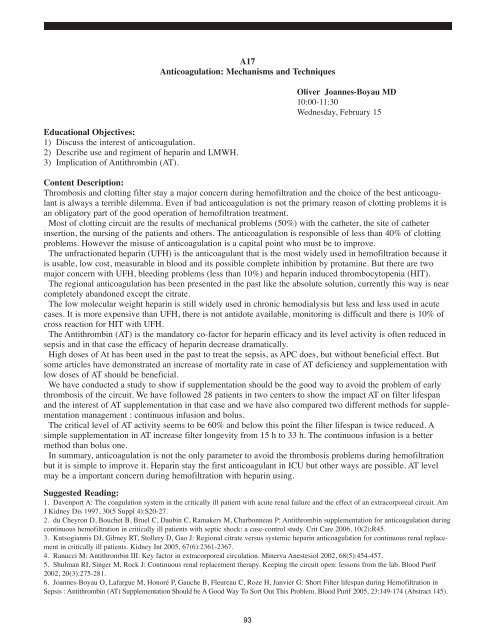ABSTRACTS from 16th International COnference on ... - CRRT Online
ABSTRACTS from 16th International COnference on ... - CRRT Online
ABSTRACTS from 16th International COnference on ... - CRRT Online
You also want an ePaper? Increase the reach of your titles
YUMPU automatically turns print PDFs into web optimized ePapers that Google loves.
Educati<strong>on</strong>al Objectives:<br />
1) Discuss the interest of anticoagulati<strong>on</strong>.<br />
2) Describe use and regiment of heparin and LMWH.<br />
3) Implicati<strong>on</strong> of Antithrombin (AT).<br />
A17<br />
Anticoagulati<strong>on</strong>: Mechanisms and Techniques<br />
Oliver Joannes-Boyau MD<br />
10:00-11:30<br />
Wednesday, February 15<br />
C<strong>on</strong>tent Descripti<strong>on</strong>:<br />
Thrombosis and clotting filter stay a major c<strong>on</strong>cern during hemofiltrati<strong>on</strong> and the choice of the best anticoagulant<br />
is always a terrible dilemma. Even if bad anticoagulati<strong>on</strong> is not the primary reas<strong>on</strong> of clotting problems it is<br />
an obligatory part of the good operati<strong>on</strong> of hemofiltrati<strong>on</strong> treatment.<br />
Most of clotting circuit are the results of mechanical problems (50%) with the catheter, the site of catheter<br />
inserti<strong>on</strong>, the nursing of the patients and others. The anticoagulati<strong>on</strong> is resp<strong>on</strong>sible of less than 40% of clotting<br />
problems. However the misuse of anticoagulati<strong>on</strong> is a capital point who must be to improve.<br />
The unfracti<strong>on</strong>ated heparin (UFH) is the anticoagulant that is the most widely used in hemofiltrati<strong>on</strong> because it<br />
is usable, low cost, measurable in blood and its possible complete inhibiti<strong>on</strong> by protamine. But there are two<br />
major c<strong>on</strong>cern with UFH, bleeding problems (less than 10%) and heparin induced thrombocytopenia (HIT).<br />
The regi<strong>on</strong>al anticoagulati<strong>on</strong> has been presented in the past like the absolute soluti<strong>on</strong>, currently this way is near<br />
completely aband<strong>on</strong>ed except the citrate.<br />
The low molecular weight heparin is still widely used in chr<strong>on</strong>ic hemodialysis but less and less used in acute<br />
cases. It is more expensive than UFH, there is not antidote available, m<strong>on</strong>itoring is difficult and there is 10% of<br />
cross reacti<strong>on</strong> for HIT with UFH.<br />
The Antithrombin (AT) is the mandatory co-factor for heparin efficacy and its level activity is often reduced in<br />
sepsis and in that case the efficacy of heparin decrease dramatically.<br />
High doses of At has been used in the past to treat the sepsis, as APC does, but without beneficial effect. But<br />
some articles have dem<strong>on</strong>strated an increase of mortality rate in case of AT deficiency and supplementati<strong>on</strong> with<br />
low doses of AT should be beneficial.<br />
We have c<strong>on</strong>ducted a study to show if supplementati<strong>on</strong> should be the good way to avoid the problem of early<br />
thrombosis of the circuit. We have followed 28 patients in two centers to show the impact AT <strong>on</strong> filter lifespan<br />
and the interest of AT supplementati<strong>on</strong> in that case and we have also compared two different methods for supplementati<strong>on</strong><br />
management : c<strong>on</strong>tinuous infusi<strong>on</strong> and bolus.<br />
The critical level of AT activity seems to be 60% and below this point the filter lifespan is twice reduced. A<br />
simple supplementati<strong>on</strong> in AT increase filter l<strong>on</strong>gevity <str<strong>on</strong>g>from</str<strong>on</strong>g> 15 h to 33 h. The c<strong>on</strong>tinuous infusi<strong>on</strong> is a better<br />
method than bolus <strong>on</strong>e.<br />
In summary, anticoagulati<strong>on</strong> is not the <strong>on</strong>ly parameter to avoid the thrombosis problems during hemofiltrati<strong>on</strong><br />
but it is simple to improve it. Heparin stay the first anticoagulant in ICU but other ways are possible. AT level<br />
may be a important c<strong>on</strong>cern during hemofiltrati<strong>on</strong> with heparin using.<br />
Suggested Reading:<br />
1. Davenport A: The coagulati<strong>on</strong> system in the critically ill patient with acute renal failure and the effect of an extracorporeal circuit. Am<br />
J Kidney Dis 1997, 30(5 Suppl 4):S20-27.<br />
2. du Cheyr<strong>on</strong> D, Bouchet B, Bruel C, Daubin C, Ramakers M, Charb<strong>on</strong>neau P: Antithrombin supplementati<strong>on</strong> for anticoagulati<strong>on</strong> during<br />
c<strong>on</strong>tinuous hemofiltrati<strong>on</strong> in critically ill patients with septic shock: a case-c<strong>on</strong>trol study. Crit Care 2006, 10(2):R45.<br />
3. Kutsogiannis DJ, Gibney RT, Stollery D, Gao J: Regi<strong>on</strong>al citrate versus systemic heparin anticoagulati<strong>on</strong> for c<strong>on</strong>tinuous renal replacement<br />
in critically ill patients. Kidney Int 2005, 67(6):2361-2367.<br />
4. Ranucci M: Antithrombin III. Key factor in extracorporeal circulati<strong>on</strong>. Minerva Anestesiol 2002, 68(5):454-457.<br />
5. Shulman RI, Singer M, Rock J: C<strong>on</strong>tinuous renal replacement therapy. Keeping the circuit open: less<strong>on</strong>s <str<strong>on</strong>g>from</str<strong>on</strong>g> the lab. Blood Purif<br />
2002, 20(3):275-281.<br />
6. Joannes-Boyau O, Lafargue M, H<strong>on</strong>oré P, Gauche B, Fleureau C, Roze H, Janvier G: Short Filter lifespan during Hemofiltrati<strong>on</strong> in<br />
Sepsis : Antithrombin (AT) Supplementati<strong>on</strong> Should be A Good Way To Sort Out This Problem. Blood Purif 2005, 23:149-174 (Abstract 145).<br />
93
















